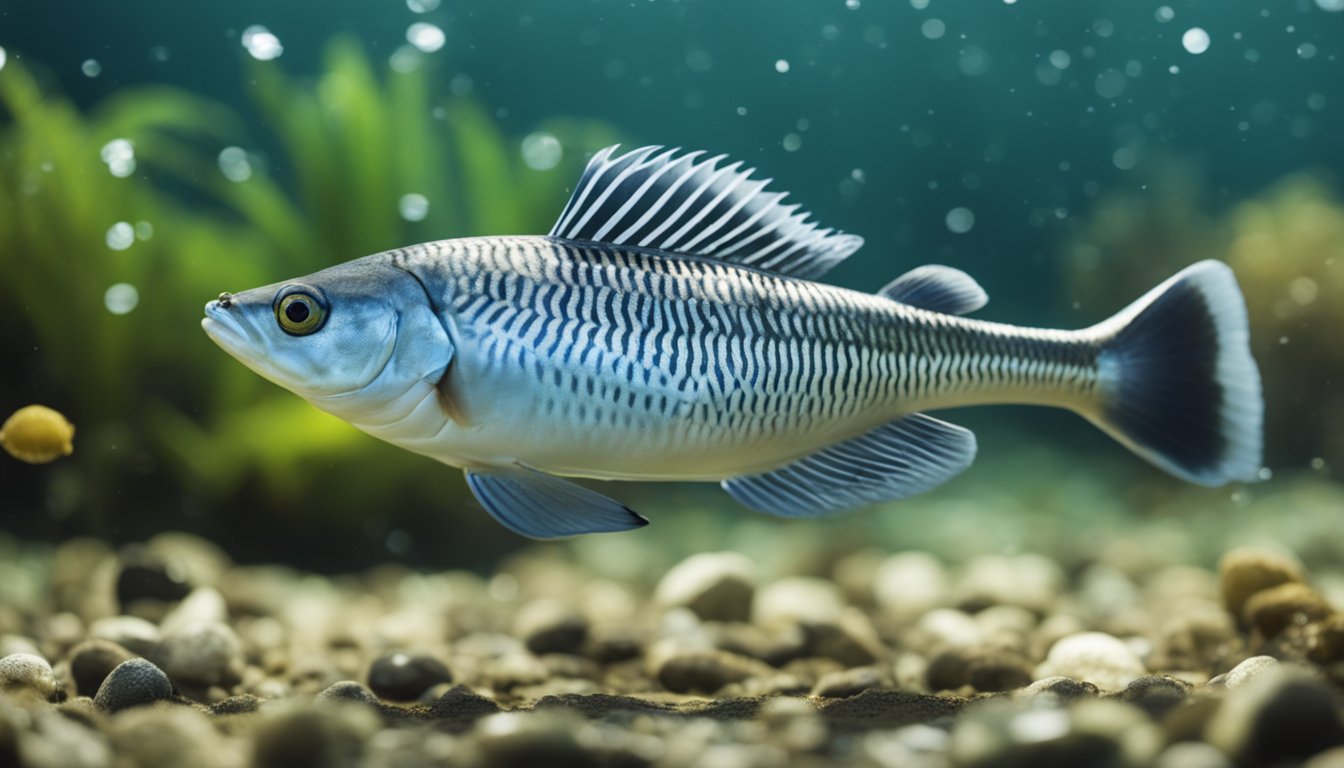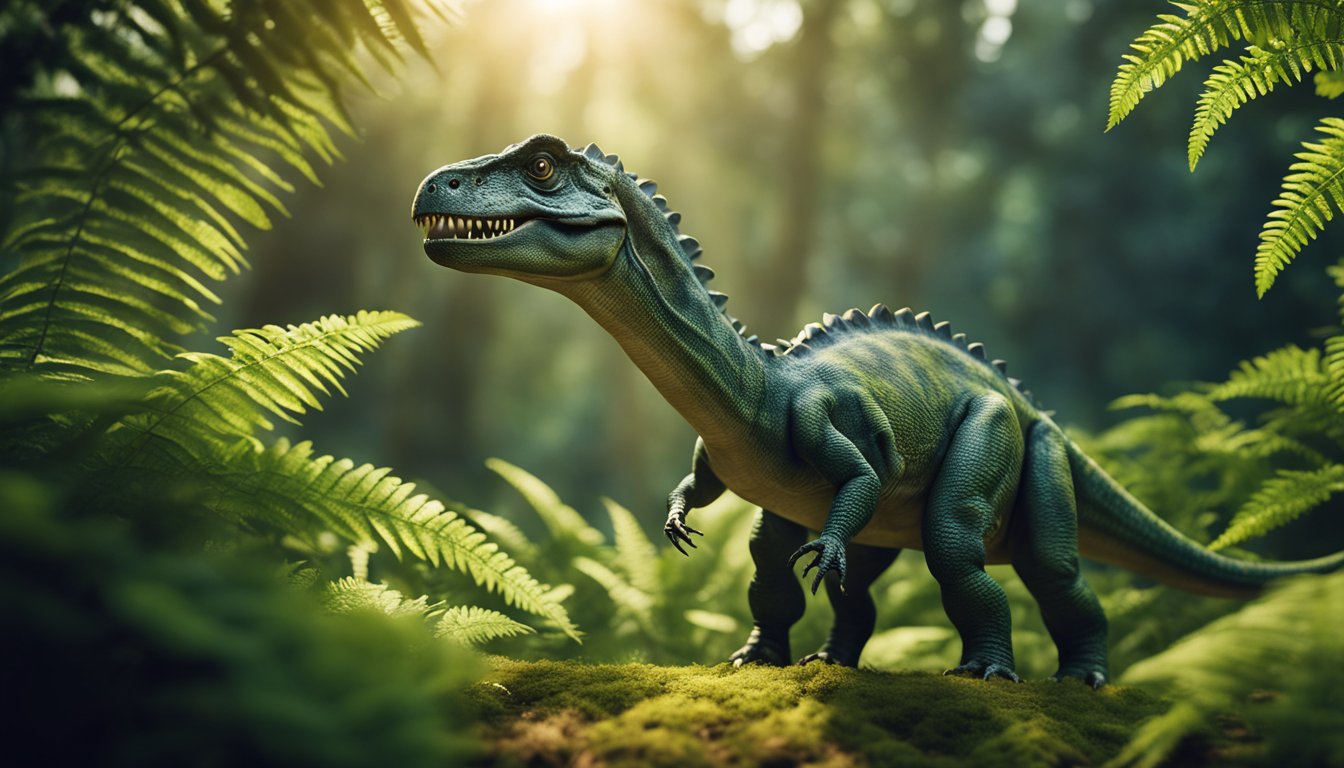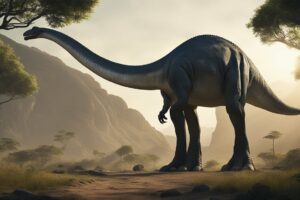Eusthenopteron, a prehistoric fish from the Late Devonian period, may hold the key to understanding how our ancestors transitioned from water to land.
This fascinating fish is significant in the study of evolution and science, as it provides insight into the development of limbs and the ability to walk.

Scientists have long been fascinated by Eusthenopteron’s unique features, particularly its powerful pectoral and pelvic fins.
Some speculate that this fish may have been able to use these fins to crawl out of the water and onto land, making it a crucial link in the evolution of tetrapods.
Recent research has shed new light on Eusthenopteron’s musculoskeletal function and how it changed during the fin-to-limb transition.
By building three-dimensional models of the fish’s pectoral appendage, scientists have been able to quantitatively examine the changes that occurred as Eusthenopteron evolved into land-dwelling creatures.
These findings provide valuable insights into the development of limbs and the ability to walk, and may help us better understand our own evolutionary history.
Unearthing the Past
Eusthenopteron is a prehistoric fish that lived during the Late Devonian period, around 385 million years ago.
Its fossils were discovered in the Miguasha Formation, a series of Devonian rocks found in Quebec, Canada.
The discovery of Eusthenopteron fossils in this region has given paleontologists a window into the Devonian world, allowing them to learn about the evolution of early vertebrates and the transition from aquatic to terrestrial life.
Fossils and Rocks
The fossils of Eusthenopteron were preserved in the Devonian rocks of Miguasha, which were formed when the region was covered by a shallow sea.
The rocks contain a wealth of information about the Devonian ecosystem, including the plants and animals that lived there.
Paleontologists have been studying the Miguasha Formation for over a century, and it remains one of the most important sources of information about the Devonian period.
Eusthenopteron fossils are particularly important because they provide evidence of the transition from fins to limbs.
The fish had a unique anatomy that allowed it to move on land, using its fins as proto-limbs.
Its fins contained bones that were homologous to the bones in the limbs of tetrapods, the group of animals that includes mammals, birds, reptiles, and amphibians.
The discovery of Eusthenopteron fossils helped scientists understand how tetrapods evolved from fish.
Miguasha: A Window to the Devonian
Miguasha is not only home to Eusthenopteron fossils but also to a diverse array of other Devonian organisms.
The site has yielded fossils of plants, invertebrates, and other fish, providing a comprehensive picture of the Devonian ecosystem.
The fossils at Miguasha are so well-preserved that they have allowed scientists to study the soft tissues of some organisms, such as the eyes of early vertebrates.
The Miguasha Formation is also important because it contains evidence of the first forests.
The Devonian period saw the rise of land plants, and Miguasha contains some of the earliest examples of trees.
These trees were relatively small, but they paved the way for the vast forests that would emerge in later periods.
In conclusion, the discovery of Eusthenopteron fossils in the Miguasha Formation has provided a wealth of information about the early evolution of vertebrates and the transition from aquatic to terrestrial life.
The fossils have allowed scientists to study the anatomy and behavior of this fascinating fish and have shed light on the origins of tetrapods.
The Miguasha Formation remains an important site for paleontologists, providing a glimpse into the Devonian world and the emergence of life on land.
The Anatomy of Walking

Eusthenopteron jenkinsi, an extinct lobe-finned fish, holds a special place in the evolution of terrestrial creatures.
Its fossilized remains helped scientists understand how fish evolved into tetrapods, or four-limbed animals, and eventually into the diverse array of land animals we know today.
This section explores the anatomy of walking, focusing on the key adaptations that allowed Eusthenopteron and its descendants to move from water to land.
From Fins to Limbs
One of the most significant changes in tetrapod evolution was the transformation of fins into limbs.
Eusthenopteron had paired fins with a complex skeletal structure that allowed it to move through water with precision and power.
However, these fins lacked the flexibility and mobility needed for walking on land.
Over time, the bones in the fins evolved to become more robust and capable of supporting the weight of the animal on land.
The humerus, radius, and ulna bones in the forelimbs, and the femur, tibia, and fibula bones in the hindlimbs, became thicker and stronger, allowing for greater stability and range of motion.
The Inner Workings: Skull and Bones
Another critical adaptation for walking was the modification of the skull and jaw.
Eusthenopteron had a flattened skull with a large, powerful jaw that was ideal for catching prey in water.
However, this skull shape was not well-suited for breathing air or supporting the weight of the animal on land.
As tetrapods evolved, the skull became more robust and triangular in shape, with a shorter snout and larger braincase.
The jaw structure also changed, with the addition of a new bone called the stapes, which helped transmit sound waves to the inner ear.
In addition to changes in the skull, the backbone and ribs also played a crucial role in the evolution of walking.
The backbone became more flexible, allowing for greater range of motion, while the ribs became more rigid, providing support for the internal organs and allowing for more efficient breathing.
In conclusion, the evolution of walking was a complex process that involved numerous adaptations in the skeleton, skull, and other parts of the body.
Eusthenopteron and its descendants played a critical role in this process, paving the way for the diverse array of land animals we know today.
By understanding the anatomy of walking, we can gain a deeper appreciation for the incredible diversity and complexity of the natural world.
Breathing New Air

Eusthenopteron, a prehistoric fish that lived around 385 million years ago, is known for its significant role in the evolution of terrestrial vertebrates.
One of the most important adaptations that allowed Eusthenopteron to move from aquatic to terrestrial environments was the development of lungs for breathing air.
The Shift from Gills to Lungs
Gills are the respiratory organs of aquatic animals. They extract oxygen from the water and release carbon dioxide.
However, when Eusthenopteron began to venture out of the water, it faced a problem.
The air had much more oxygen than water, but its gills were not designed to extract oxygen from air.
To solve this problem, Eusthenopteron developed lungs that allowed it to breathe air directly.
The evolution of lungs was a significant milestone in the history of life on Earth.
It allowed animals to exploit new environments that were previously inaccessible.
Today, lungs are found in a wide variety of terrestrial vertebrates, including reptiles, birds, and mammals.
Adapting to a Terrestrial Life
Breathing air was just one of the many adaptations that Eusthenopteron had to make to survive on land.
It also needed to develop stronger fins that could support its weight and allow it to move on land.
Over time, these fins evolved into limbs, which allowed Eusthenopteron’s descendants to walk on land.
The transition from aquatic to terrestrial life was a major event in the history of life on Earth.
It led to the evolution of a wide variety of animals, including amphibians, reptiles, birds, and mammals.
Without the evolution of lungs, this transition would not have been possible.
Fun Fact: Did you know that the largest lung in the animal kingdom belongs to the blue whale? It can hold up to 5,000 liters of air!
Eusthenopteron’s Legacy

Linking Fish and Tetrapods
Eusthenopteron foordi is a species of lobe-finned fish that lived about 385 million years ago during the late Devonian period.
It was discovered in 1881 by J.F. Whiteaves in Canada and was named after the collector, L.E. Foord.
Eusthenopteron is known for its unique skeletal features, particularly its pectoral and pelvic fins, which are similar to those of early tetrapods.
Eusthenopteron played a significant role in the evolutionary transition from fish to tetrapods.
It is considered a transitional fossil, providing valuable insight into the origin of tetrapods.
The discovery of Eusthenopteron helped scientists understand how fish evolved into tetrapods, the first four-limbed vertebrates that eventually gave rise to all land animals, including humans.
Eusthenopteron’s unique skeletal features, particularly its limbs, allowed it to move efficiently in shallow water and possibly on land.
Its limbs were muscular and flexible, allowing it to move in different directions.
The discovery of Eusthenopteron helped scientists understand how limbs evolved and how fish eventually became able to walk on land.
Eusthenopteron in the Tree of Life
Eusthenopteron belongs to a group of fish known as lobe-finned fish, which are closely related to tetrapods.
The discovery of Eusthenopteron helped scientists understand the evolutionary relationship between fish and tetrapods.
Eusthenopteron, along with other transitional fossils such as Tiktaalik, Ichthyostega, and Acanthostega, helped scientists understand the evolutionary steps that led to the emergence of tetrapods.
Eusthenopteron is also significant in the study of the tree of life.
The tree of life is a diagram that shows the evolutionary relationships between all living and extinct organisms.
Eusthenopteron’s unique features helped scientists understand how different groups of organisms are related to each other and how they evolved over time.
In conclusion, Eusthenopteron played a vital role in the evolutionary transition from fish to tetrapods.
Its unique skeletal features helped scientists understand how fish evolved into tetrapods, the first four-limbed vertebrates that eventually gave rise to all land animals, including humans.
Eusthenopteron’s discovery also helped scientists understand the evolutionary relationship between fish and tetrapods and its significance in the study of the tree of life.
Frequently Asked Questions

What ancient fish is known for its evolutionary steps towards walking on land?
Eusthenopteron is an ancient fish that is known for its evolutionary steps towards walking on land.
It lived about 385 million years ago during the Late Devonian period.
Eusthenopteron is a lobe-finned fish, which means it has fleshy fins that are supported by bones.
These fins are similar to the limbs of early tetrapods, which are the first animals to walk on land.
How did Eusthenopteron contribute to our understanding of the transition from water to land animals?
Eusthenopteron has contributed greatly to our understanding of the transition from water to land animals.
Its fossil remains have provided scientists with important information about the anatomy and behavior of early tetrapods.
For example, Eusthenopteron had a complex shoulder girdle that allowed it to support its body weight on its fins.
This is a key adaptation for walking on land, and it is thought to have been important in the evolution of tetrapod limbs.
What characteristics did Eusthenopteron have that suggest it could have been capable of movement on land?
Eusthenopteron had several characteristics that suggest it could have been capable of movement on land.
For example, it had a robust pectoral girdle and strong pelvic fins that could have been used to support its weight on land.
It also had a flexible neck and a well-developed rib cage, which would have allowed it to breathe air more efficiently.
Additionally, Eusthenopteron had a flattened head and body, which would have made it more streamlined and better suited for moving through shallow water and onto land.
How does Eusthenopteron compare to Tiktaalik in the story of vertebrate land colonization?
Eusthenopteron and Tiktaalik are both important in the story of vertebrate land colonization, but they represent different stages in the evolution of tetrapods.
Eusthenopteron is an early lobe-finned fish that shows adaptations for moving in shallow water and possibly on land.
Tiktaalik, on the other hand, is a more advanced fish that has several features of early tetrapods, including a neck, wrist bones, and a flat skull.
Tiktaalik is thought to be an important transitional form between fish and tetrapods.
What are fish-like tetrapods, and how do they relate to the evolution of terrestrial vertebrates?
Fish-like tetrapods, also known as stem tetrapods, are a group of animals that share some characteristics of both fish and tetrapods.
They lived during the Devonian period and are thought to be the earliest tetrapod ancestors.
Fish-like tetrapods had fins that were supported by bones, similar to lobe-finned fish like Eusthenopteron.
However, they also had several adaptations for life on land, including a neck, wrist bones, and a flat skull.
These adaptations allowed them to move more efficiently on land and paved the way for the evolution of terrestrial vertebrates.
Which evolutionary adaptations allowed certain fish to develop the ability to walk on land?
Several evolutionary adaptations allowed certain fish to develop the ability to walk on land.
One of the most important adaptations was the development of limbs with digits, which allowed animals to support their body weight on land.
This adaptation was preceded by the development of a bony skeleton and a neck, which allowed for greater mobility and flexibility.
Additionally, some fish developed lungs or modified swim bladders that allowed them to breathe air, which was important for survival on land.
Finally, fish that were able to move in shallow water and breathe air were better suited for life on land and were more likely to survive and reproduce.






